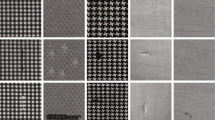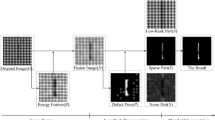Abstract
Fabric defect detection plays an important role in the quality control of textile products. Most existing defect detection techniques adopted traditional pattern recognition methods, which were lacking adaptability and presented the undesirable detection accuracy. In this paper, a fabric defect detection algorithm based on multi-channel feature matrixes extraction and joint low-rank decomposition was proposed by simulating biological visual perception mechanism. Based on the fact that the second-order gradient information is more suitable for characterizing the fabric texture, we developed a novel second-order multi-channel feature extraction method by modeling the response and distribution properties of the P-type ganglion cells in the primate retina. Upon devising a powerful descriptor, a joint low-rank decomposition method is utilized to model biological visual saliency, and decomposes the fabric images into backgrounds and salient defect objects. Experimental results demonstrate that our proposed algorithm has good self-adaptability and detection performance for plain and twill fabrics or complex patterned fabrics, and is superior to the state-of-the-art methods.







Similar content being viewed by others
References
Baykal IC, Muscedere R, Jullien GA (2002) On the use of hash functions for defect detection in textures for in-camera web inspection systems. In: IEEE International symposium on circuits and systems, vol 5. IEEE, pp V-665-V-668
Brzakovic D, Bakic P, Vujovic N, et al (1997) A generalized development environment for inspection of web material. In: IEEE International conference on robotics and automation, vol 1. IEEE Press, New York, pp 1–8
Cao J, Zhang J, Wen Z (2015) Fabric defect inspection using prior knowledge guided least squares regression. Multimed Tools Appl 76(3):1–17
Cohen FS, Fan Z, Attali S (1991) Automated inspection of textile fabrics using textual models. IEEE Trans Pattern Anal Mach Intell 13(8):803–808
Guan S (2016) Fabric defect detection using an integrated model of bottom-up and top-down visual attention. J Textile Institute 107(2):215–224
Guan S, Gao Z, Wu N, et al (2014) Defect detection of plain weave based on visual saliency mechanism. J Textile Res 35(4):56–61
Hou X, Zhang L (2007) Saliency detection: a spectral residual approach. Comput Vis Pattern Recogn, 1–8
Huang D, Zhu C, Wang Y, et al (2014) HSOG: a novel local image descriptor based on histograms of the second-order gradients. IEEE Trans Image Process 23(11):4680–4695
Imamoglu N, Lin W, Fang Y (2013) A saliency detection model using low-level features based on wavelet transform. IEEE Trans Multimed 15(1):96–105
Kamermans M, Hark J, Habraken J, et al (1996) The size of the horizontal cell receptive fields adapts to the stimulus in the light adapted goldfish retina. Vis Res 36(24):4105–4119
Lang C, Liu G, Yu J, Yan S (2012) Saliency detection by multitask sparsity pursuit. IEEE Trans Image Process 21(3):1327–1338
Li C, Gao GS, Liu Z, et al (2017) Fabric defect detection algorithm based on histogram of oriented gradient and low-rank decomposition. J Textile Res 38(3):153–158
Li C, Yang R, Liu Z, et al (2016) Fabric defect detection via learned dictionary-based visual saliency. Int J Cloth Sci Technol 28(4):530–542
Li C, Zhang Z, Liu Z, et al (2014) A novel fabric defect detection algorithm using textural difference-based visual saliency model. J Shandong Univ (Eng Sci) 44(4):1–9
Li M, Cui S, Xie Z (2015) Application of Gaussian mixture model on defect detection of print fabric. J Textile Res 36(8):94–98
Li Y, Li H, Gong HQ, et al (2011) Characteristics of receptive field encoded by synchronized firing pattern of ganglion cell group. Acta Biophysica Sinica 27(3):211–221
Li X, Li Y, Shen C, et al (2013) Contextual hypergraph modeling for salient object detection. In: IEEE International conference on computer vision. IEEE, pp 3328–3335
Li Y, Zhao W, Pan J (2017) Deformable patterned fabric defect detection with fisher criterion-based deep learning. IEEE Trans Autom Sci Eng 14(2):1256–1264
Lin Z, Liu R, Su Z (2011) Linearized alternating direction method with adaptive penalty for low-rank representation. Adv Neural Inf Process Syst, 612–620
Liu G, Lin Z, Yu Y (2010) Robust subspace segmentation by low-rank representation. In: International conference on machine learning, pp 663–670
Liu Z, Li C, Zhao Q, et al (2015) A fabric defect detection algorithm via context-based local texture saliency analysis. Int J Cloth Sci Technol 27(5):738–750
Ng MK, Ngan HYT, Yuan X, et al (2014) Patterned fabric inspection and visualization by the method of image decomposition. IEEE Trans Autom Sci Eng 11 (3):943–947
Ngan HYT, Pang GKH (2006) Novel method for patterned fabric inspection using Bollinger bands. Opt Eng 45(8):087202
Ngan HYT, Pang GKH, Yung SP, et al (2005) Wavelet based methods on patterned fabric defect detection. Pattern Recogn 38(4):559–576
Peng H, Li B, Ling H, et al (2016) Salient object detection via structured matrix decomposition. IEEE Trans Pattern Anal Mach Intell 39(4):818–832
Qu T, Zou L, Zhang Q, et al (2016) Defect detection on the fabric with complex texture via dual-scale over-complete dictionary. J Textile Institute 107(6):743–756
Rodieck R (1965) Quantitative analysis of cat retinal ganglion cell response to visual stimuli. Vision Res 5(12):583–601
Selver M, Avşar V, Özdemir H (2014) Textural fabric defect detection using statistical texture transformations and gradient search. J Text Inst 105(9):998–1007
Shapley R (1997) Retinal physiology: adapting to the changing scene. Curr Biol 7(7):R421–R423
Shen X, Wu Y (2012) A unified approach to salient object detection via low rank matrix recovery. IEEE Conf Comput Vis Pattern Recogn 23(10):853–860
Tang C, Wang P, Zhang C, et al (2017) Salient object detection via weighted low rank matrix recovery. IEEE Signal Process Lett 24(4):490–494
Toh K-C, Yun S (2010) An accelerated proximal gradient algorithm for nuclear norm regularized least squares problems. Pac J Optim 6(3):615–640
Tong L, Wong WK, Kwong CK (2017) Fabric defect detection for apparel industry: a nonlocal sparse representation approach. IEEE Access 5(99):5947–5964
Weng D, Wang Y, Gong M, et al (2015) DERF: distinctive efficient robust features from the biological modeling of the p ganglion cells. IEEE Trans Image Process 24(8):2287–2302
Workgroup on texture analysis of DFG TILDA textile texture database[DB/OL] [2013-05-06]. http://lmb.informatik.uni-freiburg.de/research/dfg-texture/tilda
Xia D, Jiang G, Li Y, et al (2017) Warp-knitted fabric defect segmentation based on non-subsampled contour let transform. J Textile Institute 108(2):239–245
Yang X, Pang CG, Yung N (2005) Robust fabric defect detection and classification using multiple adaptive wavelets. IEE Proc-Vis Image Signal Process 152(6):715723
Yan J, Liu J, Li Y, et al (2010) Visual saliency detection via rank-sparsity decomposition. IEEE Int Conf Image Process 119(5):1089–1092
Ying S (2014) Fabric defects detection using adaptive wavelets. Int J Cloth Sci Technol 26(3):202–211
Zengbo X, Yunan G, Xiubao H (2000) Fabric detects detection with wold-based texture model and fractal. Theory 26(1):6–9
Zhang D, Gao G, Li C (2016) Fabric defect detection algorithm based on Gabor filter and low-rank decomposition. In: Eighth International conference on digital image processing, pp 100330L1–100330L6
Zhou J, Wang J (2013) Fabric defect detection using adaptive dictionaries. Text Res J 83(17):1846–1859
Zhou J, Semenovich D, Sowmya A, et al (2014) Dictionary learning framework for fabric defect detection. J Text Inst 105(3):223–234
Zhu Q, Wu M, Li J, Deng D (2012) Fabric defect detection via small scale over-complete basis set. Textile Res J 84(15):1634–1649
Acknowledgements
This work was supported by the National Natural Science Foundation of China ((No.61772576, No.61379113), the Key Natural Science Foundation of Henan Province(No.162300410338), Science and technology innovation talent project of Education Department of Henan Province(17HASTIT019), The Henan Science Fund for Distinguished Young Scholars (184100510002).
Author information
Authors and Affiliations
Corresponding author
Additional information
Publisher’s Note
Springer Nature remains neutral with regard to jurisdictional claims in published maps and institutional affiliations.
Rights and permissions
About this article
Cite this article
Li, C., Liu, C., Gao, G. et al. Robust low-rank decomposition of multi-channel feature matrices for fabric defect detection. Multimed Tools Appl 78, 7321–7339 (2019). https://doi.org/10.1007/s11042-018-6483-6
Received:
Revised:
Accepted:
Published:
Issue Date:
DOI: https://doi.org/10.1007/s11042-018-6483-6




